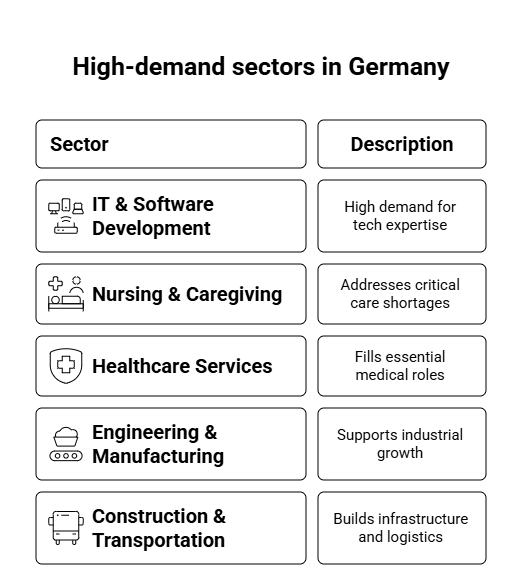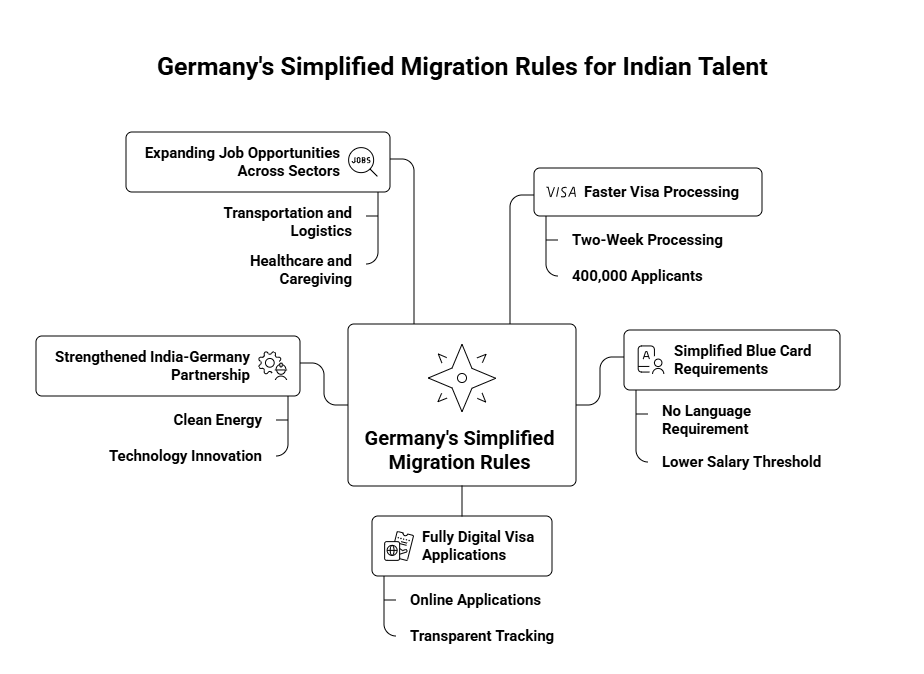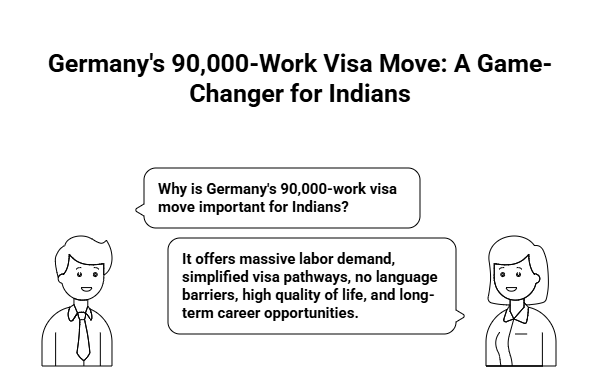Posted on October 22 2025
Germany to offer 90,000 work visas to Indian professionals in 2025. Apply now!
By , Editor
Updated October 27 2025
Highlights: Germany’s 90,000-Visa Move Boosts Opportunities for Indians
- Germany will increase annual work visas for Indian professionals from 20,000 to 90,000, marking a major boost in labour mobility between the two countries.
- Visa processing times have been cut drastically — Indian applicants will now get approvals within two weeks instead of nine months.
- The German Blue Card process has been simplified, with relaxed language requirements and lower salary thresholds for skilled workers.
- Over 570,000 job vacancies remain unfilled across Germany, creating strong demand for international professionals.
- IT, healthcare, and engineering sectors are among the top fields where Indian talent will be prioritized.
*Want to apply for a German work visa? Let Y-Axis help you with the steps.
Germany Opens 90,000 Work Visa Slots for Indian Skilled Talent
Germany is facing one of its most severe labour shortages in decades. With nearly 570,000 job vacancies and acute skill gaps across industries, the country has turned to India, one of the world’s largest talent pools, to meet its workforce needs.
According to Philipp Ackermann, the German Ambassador to India, the number of work visas issued to skilled Indian professionals is expected to increase from 20,000 to 90,000 per year. This expansion reflects Germany’s growing dependence on international talent to sustain its economy and demographic stability.
The initiative aims to attract Indian workers in key high-demand sectors including:
- Information technology and software development
- Nursing and caregiving
- Healthcare services
- Engineering and manufacturing
- Construction and transportation

Germany’s approach closely follows Japan’s model of workforce integration, which has successfully tapped into Indian talent to fill critical skill shortages.
*Looking for jobs in Germany? Avail Y-Axis Job search services to find the right one!
Germany Simplifies Migration Rules to Attract More Indian Talent
Germany has announced a series of migration-friendly reforms to make it faster and easier for Indian professionals to live and work in the country.
These new measures aim to simplify the visa process, promote digitalisation, and strengthen cooperation between India and Germany — all while addressing the country’s growing labour shortage.
Here’s how these changes will make a real difference for Indian applicants:
- Faster Visa Processing
Germany has drastically reduced the visa processing time for Indian professionals. Instead of waiting for months, applicants can now get their work visa processed in just two weeks, compared to the previous nine-month waiting period.
This improvement will benefit nearly 400,000 Indian applicants who were earlier affected by visa delays, helping them move to Germany faster and start working without unnecessary waiting.
- Simplified Blue Card Requirements
Germany has removed the strict German language requirement for EU Blue Card applicants, making it easier for non-German speakers to qualify.
The salary threshold has also been lowered, and professionals with relevant degrees are now eligible for more job categories.
This is great news for Indian professionals in IT, engineering, and technical fields, as they can now access high-paying opportunities without facing language or salary barriers.
- Fully Digital Visa Applications
By the end of 2024, Germany and other Schengen Area countries will move to a completely digital visa system.
Indian applicants will soon be able to apply for visas online, eliminating the need to visit consulates or embassies in person.
This shift to digital processing will make applying for a Schengen visa faster, easier, and more transparent, allowing professionals to track and manage their applications conveniently.
- Strengthened India-Germany Partnership
India and Germany are planning new rounds of bilateral discussions to enhance cooperation in skill development and workforce mobility.
This partnership will play a key role in areas such as clean energy, technology innovation, and healthcare, where India’s skilled workforce can directly support Germany’s economic goals.
The collaboration is expected to open more professional avenues for Indian workers, especially in emerging industries.
- Expanding Job Opportunities Across Sectors
According to the German Economic Institute, there are currently 570,000 unfilled job positions across more than 70 sectors in Germany.
The European Labour Authority (ELA) notes particularly high demand in:
- Transportation and logistics
- Manufacturing and machine operations
- Healthcare and caregiving
- Construction and skilled trades
- Information technology

For Indian professionals, these numbers highlight a golden opportunity to pursue rewarding careers in one of Europe’s most advanced economies.
*Looking to work in Germany? Sign up with Y-Axis for end-to-end support with the process.
Why Germany’s 90,000-Work Visa Move Is a Game-Changer for Indians
Germany’s decision to expand its annual work visa quota for Indian professionals is more than just a policy change — it’s a strategic shift in global workforce mobility. Experts predict that Germany will face a labour shortage of over 7 million workers by 2035 if migration rates remain low. To fill these gaps, the country is seeking to attract skilled talent from high-growth nations like India.
For Indian professionals, this presents a rare, once-in-a-decade opportunity to build a life and career in a country that values skill, innovation, and diversity.
Here’s why this move matters for Indians planning to work or settle abroad:
- Massive Labour Demand: Germany is already facing 570,000+ unfilled positions across sectors like IT, engineering, healthcare, and manufacturing — offering abundant job opportunities for Indian professionals
- Simplified Visa Pathways: The new 90,000-work visa quota and faster 2-week processing make Germany one of the easiest European destinations to migrate to.
- No Language Barriers: The removal of strict German language requirements and lower salary thresholds under the Blue Card scheme make it easier for Indians to qualify.
- High Quality of Life: Germany offers world-class healthcare, free education, strong worker rights, and an excellent work-life balance, making it ideal for families.
- Long-Term Career and PR Opportunities: Skilled workers can easily transition to permanent residency and eventually citizenship, ensuring long-term stability abroad.

*Are you looking for step-by-step assistance for German immigration? Contact Y-Axis, the world’s No. 1 overseas immigration consultancy, for end-to-end support!
For recent Schengen updates, check out Y-Axis Schengen news page!
FAQs
1. What has Germany announced regarding work visas for Indian professionals?
Germany has announced plans to significantly increase its annual work visa quota for Indian professionals from 20,000 to 90,000. This decision comes as part of the country’s broader workforce strategy to attract global talent, address skill shortages, and strengthen its bilateral relationship with India. The move aims to make migration smoother and faster for skilled Indian workers across key sectors such as information technology, engineering, and healthcare. By expanding the visa cap, Germany is positioning itself as one of the most open and immigrant-friendly economies in Europe for qualified professionals.
2. Why is Germany increasing work visas for Indians?
Germany is facing one of the most severe labour shortages in its history. The nation has an ageing population and more than 570,000 unfilled positions across major sectors like healthcare, IT, and engineering. To sustain its economic growth and maintain competitiveness, Germany is seeking skilled professionals from abroad—particularly from India, a country known for its strong pool of highly educated and experienced workers. Increasing work visas for Indians will help bridge the skill gap, drive innovation, and build a sustainable workforce to support Germany’s industrial and technological ambitions in the coming years.
3. Which sectors in Germany will hire more Indian workers?
Germany is prioritizing skilled professionals from India in high-demand sectors that are currently facing acute labour shortages. These include information technology, software development, nursing, caregiving, healthcare, engineering, manufacturing, construction, and transportation. The focus on these industries stems from the country’s urgent need to fill technical and service-oriented roles essential for maintaining its economic stability and public welfare. Indian professionals are highly regarded for their expertise in these areas, making them a valuable addition to the German workforce. The collaboration is expected to strengthen Indo-German relations and create new employment pathways for Indian talent.
4. How long does it take for Indian applicants to get a German work visa now?
Germany has significantly reduced its visa processing time for Indian applicants to make migration faster and more efficient. Previously, professionals had to wait up to nine months to receive a decision. Under the new reforms, the average processing time has been shortened to just two weeks. This major improvement will benefit nearly 400,000 Indian candidates who were affected by long visa backlogs. The streamlined process reflects Germany’s commitment to becoming more accessible for skilled international workers, helping Indian professionals relocate quickly to begin their careers in one of Europe’s most dynamic job markets.
5. What changes have been made to Germany’s Blue Card requirements?
Germany has introduced major reforms to its EU Blue Card system to make it more inclusive and flexible. The government has removed the mandatory German language requirement for most applicants, making it easier for non-German speakers to qualify. The salary threshold for Blue Card eligibility has also been reduced, allowing more professionals to apply. In addition, individuals with relevant university degrees or technical qualifications can now secure employment in Germany more easily. These changes are designed to attract top international talent—especially from India—and simplify the process for highly skilled workers to build careers in Germany.
6. Will Indian applicants be able to apply for German visas online?
Yes. Germany, along with other Schengen countries, will soon introduce a fully digital visa system that allows non-EU citizens, including Indian applicants, to apply for visas online. The new system, expected to be implemented by the end of 2024, will replace traditional paper-based applications. This initiative will make the process faster, more transparent, and more convenient for applicants worldwide. By digitizing the entire process, Germany aims to enhance accessibility and reduce wait times, helping Indian professionals manage their visa applications efficiently without the need for in-person visits to embassies or consulates.
7. How many job vacancies currently exist in Germany?
Germany currently has over 570,000 unfilled job positions across more than 70 occupations, highlighting the scale of its workforce challenges. The shortage spans both technical and service industries, including healthcare, transportation, IT, engineering, and skilled trades. The German Economic Institute attributes these vacancies to demographic shifts and a growing demand for skilled labour in key sectors. To meet this need, Germany is expanding its recruitment of foreign talent—particularly from India, where professionals possess the expertise and training that align well with German industry requirements and the evolving European job market.
8. What are the most in-demand jobs in Germany right now?
Germany is experiencing high demand for professionals in a wide range of roles, including IT specialists, engineers, machine operators, healthcare workers, cabinet makers, and food preparers. Transportation and logistics professionals are also in short supply, particularly drivers and skilled tradespeople. The European Labour Authority has identified these roles among the most critical to fill in 2025 and beyond. As automation, digitalization, and healthcare needs continue to rise, Germany is opening doors to skilled Indian workers who can help strengthen these industries and support the nation’s long-term economic stability.
9. Does Germany require Indian workers to know German for work visas?
No, German language proficiency is no longer a strict requirement for skilled professionals applying under the new visa or EU Blue Card pathways. While learning German is still encouraged for better integration, it is not mandatory for most job roles. The new reforms prioritize skills, qualifications, and experience over language ability, especially for professionals in IT, engineering, and healthcare. This change makes Germany far more accessible to Indian talent, allowing qualified applicants to secure positions quickly while adapting to the local culture and language after arrival.
10. How will these changes benefit Indian professionals?
Germany’s new visa reforms create an exceptional opportunity for Indian professionals to access one of the world’s strongest job markets. Faster visa processing, relaxed language rules, and simplified qualification criteria make migration easier than ever. With over 570,000 open positions and a focus on high-growth industries like technology, healthcare, and engineering, Indian workers can expect rewarding careers, long-term stability, and access to Europe’s high living standards. Additionally, Germany offers a clear pathway to permanent residency, family benefits, and strong worker protections—making it an ideal destination for professionals seeking global opportunities.
Tags:
Germany work visa
Work in Germany
German visas
German immigration news
German immigration
Germany immigration
Migrate to Germany
Jobs in Germany
Jobs in Germany for Indians
Germany work visa
German work visas for Indians
Share
Options for you by Y-Axis
Get it on your mobile
Get News alerts
Contact Y-Axis

